
 KWIK TOUR
KWIK TOUR
 KWIK TOUR
KWIK TOUR
 The jumper is experiencing freedom.
Leaping over and into unknown risks, he works
toward a goal.
The jumper is experiencing freedom.
Leaping over and into unknown risks, he works
toward a goal.
There are feelings of flying into the future, perhaps similar to something you have experienced.
A crevasse is a crack or fissure in a glacier (a slowly moving river of ice). The extent of the opening is often concealed by crusty snow. The jumper may break through and dangle in the abyss while his companions try to haul him up.
If feelings of flying seem far away from technology, welcome to Kwik Tour. We should be able to cover the distance in an hour, or less if you're in a hurry. The current speed record is eight minutes and 42 seconds.Why, you may ask, both feelings and technology? What is the point of combining them?

We feel anxiety when our structures of experience become insecure, sometimes involving freedom, e.g while:
-- Push it, already, there's nowhere else to go...

The Kwik Tour hyperchopper just passed over the lip of the canyon, folks. It's not very deep here, but you might run over that transition again and become familiar with the feeling.
-- One small side-step through hyperspace.
The mountain is up ahead, hidden in clouds -- seems like it's always hidden in clouds, but we'll see more near Base Camp.
Our first stop is at the deepest point of Water Trail, in a cave. You might think it's weird to climb a mountain out of a cave, but that's how this Trail goes.
Now, before you click away, folks, remember that we're at a high level of disorder here and some things may look and feel strange. What you experience will have features of form different from what you are used to.
Around here, entities that you expect to be solid can break up into multiple images that sometimes fit together, but sometimes not. Getting acclimated means sustaining multiple images simultaneously. It's very interesting to watch these images come together, break apart, and organize and dis-organize one another.
We meet up with Water Trail near the Lair of the Hairy Hypothesis (There's something wild loose in here!). You encounter The Pit in a primal aspect.
After you visit The Wild God, push the Kwik Tour Button
to continue.
You can Skip church
All materials copyright by Robert Kovsky, 1997.
[Kwik Tour resumes after The Wild God]
Let's go, folks, the hyperchopper will take us into the light and FRESH AIR.
That cave's an interesting place to visit, but we don't want to get stuck there. Just remember, it pumps the fuel to run the hyperchopper and all the equipment on this mountain. We climb out of the cave, but we can't get away from it.
Now, we're moving in close to view the first part of the climb. What a mess! There's scraps of rope, odd bits of metal pounded into cracks and one place where the only thing to do is jump. Plus lots of garbage left behind. There were even some used diapers, but they've been buried.
Folks, there's no way to do that climb clean. No way to do it with certainty. Some tried to do it clean and with certainty. They tried it with scriptures; they tried it by thinking ("I think, therefore I am"); they tried it with the scientific method. All lead away from the summit of freedom.
The only way left was a kludge. When you have to do something, and there's no clean way to do it, you stick stuff together until it works: that's a kludge.
"Kludge made Alsing imagine a wheel built out of bricks, with wooden wedges between them; such a thing might work, but no sane engineer would be proud to have designed it." Kidder, The Soul of a New Machine (1981) at 103.
All materials copyright by Robert Kovsky, 1997.
Freedom is a kludge.
A big kludge is structure.
Freedom is a kludge that makes kludges.There's "natural structure," the way it's made in our brains. That's too hard to figure out, so we kludge it and make an artificial system of structure.
The Way of Error
Oh, it's an old way, a new way, a sad way, a glad way. It's a way to climb by an accumulation of steps, nearly every one wrong, but all tending toward the goal and gettin' there too, so long as you allow for adjustment of what there means.People have been climbing on this mountain for thousands of years. Many different people and many different ways. This project owes much to pioneers too numerous to list, whose names can be found on the internet and in libraries world-wide. So, as we move in on The Way of Error, you may recognize some familiar features.

[Back to Kwik Tour from the Way of Error]
That last step on the Way of Error ("reflection") is a tricky one. We'll see it from another angle later on. And you can walk it in detail if you follow High Path out of Base Camp.
Now, we're going to angle back and fly over Ridge Route. We'll meet Ridge Route and follow it up.
Folks, we can assemble structures by putting dots and lines together like tinker toys or a gerbil maze. We can build dot-and-line structures as big as we please. That's easy. But if you're inside the maze, you want to know where you are and where you're going.
You're inside a maze right now -- this website. Here you know where you are -- you're with the Tourguid. Just look at the name of this page at the top of your browser.
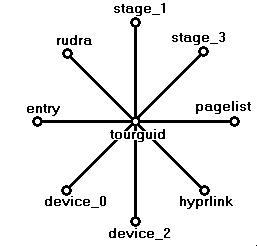 Let's start off with a dot-and-line picture of
the website from the viewpoint of Tourguid.
There's Tourguid at the center and around it are
other pages in the website connected to Tourguid by
hypertext links.
Let's start off with a dot-and-line picture of
the website from the viewpoint of Tourguid.
There's Tourguid at the center and around it are
other pages in the website connected to Tourguid by
hypertext links.
Each line connected to Tourguid stands for two hypertext links: one from Tourguid to the other page and one from the other page back to Tourguid. Just imagine there's arrowheads at both ends of the lines.
(Those other pages are also connected to each other and to still more pages, but we'll ignore those additional hypertext links for now.)

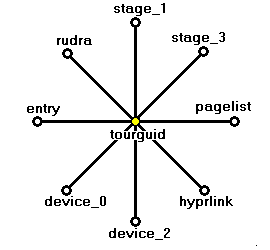 Next, we indicate where you are in the maze
by coloring the appropriate dot yellow -- like a light bulb
that's on. It's where you
are, but we project it and say
that it marks consciousness.
The maze is not conscious; neither
are the devices that explore the maze.
They can, however, serve as tools for
your consciousness.
Next, we indicate where you are in the maze
by coloring the appropriate dot yellow -- like a light bulb
that's on. It's where you
are, but we project it and say
that it marks consciousness.
The maze is not conscious; neither
are the devices that explore the maze.
They can, however, serve as tools for
your consciousness.
The projected consciousness is called an on_location.
Each dot is a location and now Tourguid is the one that's on.

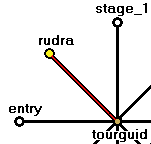 When you went for a visit to The Wild God,
the Tourguid location got turned off
and the Rudra location got turned on.
When you went for a visit to The Wild God,
the Tourguid location got turned off
and the Rudra location got turned on.
That's the simplest possible step.
The location where the step started is colored brown;
the location where the step ended is colored yellow;
and the step is colored red.
The devices of Ridge Route take steps, but there's a feature of greater complexity. A step can start with several locations and end up with several locations.
You can see how a device works at device_0 of Ridge Route.

[Back to Kwik Tour from Device_0]
Now, folks, there's a big problem with Device_0.

 <---- You want this
<---- You want this
But you get this ---->
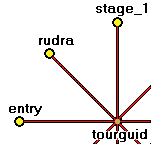

The "projected consciousness" goes off in all directions, as if it were coming out of a random generator. But real consciousness is guided by purposeful selection.
 We need something that selects like the
Buttons you click with the browser:
We need something that selects like the
Buttons you click with the browser:
To accomplish this selection, Water Trail and Ridge Route converge on an extension of the structural event.
First, we re-trace the last step of The Way of Error ("reflection") where the artificial psychology operates on its own element:
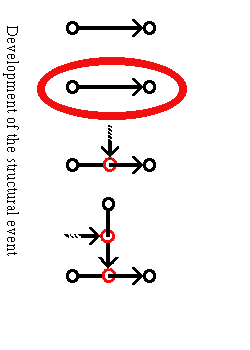


The two-part structural event (context-detail pair) is explicated into a separate entity.
Then it is projected into the structure ---
--- and identified as a location ---
--- that is available for combination with other locations.
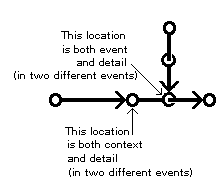 The two-part structural event has developed into a three-part
structural event.
The two-part structural event has developed into a three-part
structural event.Some locations take on two roles:
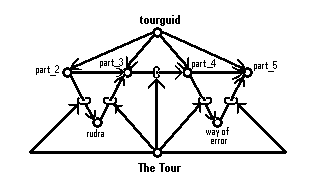 Events also trace out paths.
Events also trace out paths.
The tourguid page divides into parts and the various parts
link into other pages and back again. The succession
of links traces out a path that makes up "The Tour"
that you've been on. A few of the links on The Tour are
shown in the adjacent image.
Let's look at how device_2 uses the three-part structure to select locations.
Let's not.

The machinery of device_2 provides some insight into the higher reaches of Water Trail. First, let's revisit the machinery of device_0 with a pictorial notation:
 You see the simple structural event
(two dots connected by an arrow)
with
a forward step "F" indicated in red with a half-arrow.
Likewise, a reverse step "R" is indicated with a blue half-arrow.
You see the simple structural event
(two dots connected by an arrow)
with
a forward step "F" indicated in red with a half-arrow.
Likewise, a reverse step "R" is indicated with a blue half-arrow.
 Next, there's a similar pictorial notation
for the extended three-part structure. There's a half-step "s"
indicated with a dark green half-arrow, like the forward step. It moves
from a context to an event. And there's a reverse half-step
s-1" indicated
with a light green half-arrow, moving from an event to a context.
Next, there's a similar pictorial notation
for the extended three-part structure. There's a half-step "s"
indicated with a dark green half-arrow, like the forward step. It moves
from a context to an event. And there's a reverse half-step
s-1" indicated
with a light green half-arrow, moving from an event to a context.
Then, there's another half-step "t" indicated with a dark brown half-arrow (from event to detail), plus a reverse half-step t-1" indicated with a light brown half-arrow (moving from detail to event).
The green half-steps shuttle between contexts and events and the brown half-steps shuttle between events and details. Half-steps in parallel (simultaneously) and in series (after each other in concatenation) can explore any structure in a systematic fashion.
Structures built out of three-part elements are hierarchical. There are contexts
and details and these generally correspond to natural experiences,
like documents, keywords or relations. Contexts and details are involved in events;
and the events
are invented locations
and in this system. Each half-step
shuttles between a context or detail relatively natural and an event relatively invented.

 Another view of device_2 puts the transfer commands and the half-step commands
into a single diagram. Each of the curved lines represents a pair of
commands. The shuttle of on_locations moves around, between contexts and details,
contexts and events, and events and details, combining and selecting among the locations,
integrating through action a mixture of natural and invented elements.
Another view of device_2 puts the transfer commands and the half-step commands
into a single diagram. Each of the curved lines represents a pair of
commands. The shuttle of on_locations moves around, between contexts and details,
contexts and events, and events and details, combining and selecting among the locations,
integrating through action a mixture of natural and invented elements.
This activity resembles the integration of reality and structured experience observed in the exercise of natural freedom.


The adjacent image is an ambiguity structure illustrating the technology of freedom.


